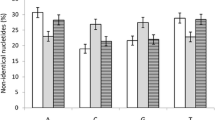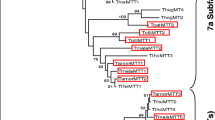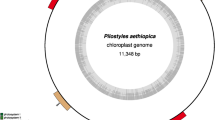Summary
The turkey metallothionein gene (tkMT) was isolated from a phage lambda-turkey genomic DNA library by virtue of high identity with chicken MT cDNA. The nucleotide sequences of the proximal 240 by of the 5′-flanking region, of each of the three exons, and of the intron/exon boundaries were determined. Comparisons of the nucleotide sequences of the tkMT and cMT genes revealed (1) absolute conservation of intronic DNA immediately flanking each respective intron/exon boundary, (2) high conservation (95.6%) of exonic DNA encoding translated regions of the mRNA, and (3) high conservation (95%) of exonic DNA encompassing the putative transcription start point and polyadenylation signals. Sequence comparisons of the tkMT and cMT promoters regions near the TATA box revealed that both promoters contain a highly conserved proximal metal-responsive enhancer (MRE-enhancer) motif. The deduced amino acid sequence (63 amino acids) of tkMT was identical with that of cMT. In order to further explore the degree of conservation of the protein coding regions of avian MT genes, partial MT cDNAs from turkey, quail (qMT), and pheasant (pMT) were amplified using the reverse transcriptase-polymerase chain reaction (RT-PCR) and primers corresponding to the amino- and carboxyl-terminal coding regions of cMT mRNA. RT-PCR reaction products were cloned and the DNA sequences of multiple cDNA clones from each species were determined. The results suggest the existence of a single MT mRNA in zinc-treated liver from turkey and pheasant and the existence of a major and possibly a minor MT mRNA in quail. Comparisons of the nucleotide sequences of the predominant cMT, tkMT, qMT, and pMT cDNAs revealed exceptionally high identity (97%) and the deduced MT peptide sequences (residues 15-57) were identical. The data suggest that the nucleotide sequence of these avian MT cDNAs is evolving at a predictably slow rate, but that the amino acid sequence of the encoded protein is exceptionally well conserved.
Similar content being viewed by others
References
Ahlquist JE, Bledsoe AH, Sheldon FH, Sibley CG (1987) DNA hybridization and avian systematics. Auk 104:556–563
Andrews GK (1990) Regulation of metallothionein gene expression. Prog Food Nutr Sci 14:193–258
Andrews GK, Fernando LP (1991) Molecular biology of the chicken metallothionein gene. In: Klaassen CD, Suzuki KT (eds) Metallothionein in biology and medicine. CRC Press, Boca Raton, p 103
Andrews GK, Huet YM, Lehman LD, Dey SK (1987) Metallothionein gene regulation in the preimplantation rabbit blastocyst. Development 100:463–469
Bonham K, Zafarullah M, Gedamu, L (1987) The rainbow trout metallothioneins: molecular cloning and characterization of two distinct cDNA sequences. DNA 6:519–528
Breathnach R, Chambon P (1981) Organization and expression of eukaryotic split genes. Ann Rev Biochem 50:349–384
Catzeflis FM, Sheldon FH, Ahlquist JE, Sibley CG (1987) DNA-DNA hybridization evidence of the rapid rate of muroid rodent DNA evolution. Mol Biol Evol 4:1–37
Fernando LP, Andrews GK (1989) Cloning and expression of an avian metallothionein gene. Gene 81:177–183
Fernando LP, Wei D, Andrews GK (1989) Structure and expression of chicken metallothionein. J Nutr 119:309–318
Green MR (1986) Pre-mRNA splicing. Ann Rev Genet 20:671–708
Hamer DH (1986) Metallothionein. Ann Rev Biochem 55:915–951
Kadonaga JT, Carner KR, Masiarz FR, Tjian R (1987) Isolation of cDNA encoding transcription factor Sp1 and functional analysis of the DNA binding domain. Cell 51:1079–1090
Karin M, Richards RI (1982) Human metallothionein genes—primary structure of the metallothionein II gene and a related processed gene. Nature 299:797–802
Kille P, Stephens PE, Kay J (1991) Elucidation of cDNA sequences for metallothioneins from rainbow trout, stone loach and pike liver using the polymerase chain reaction. Biochem Biophys Acta 1089:407–410
Lin L, Huang PC (1990) Complete homology in metallothionein from two genera of ducks and their hybrids. Biochem Biophys Res Commun 168:182–187
Lin L, Lin WC, Huang PC (1990b) Pigeon metallothionein consists of two species. Biochim Biophys ACTA 1037:248–255
Lin L, Liu L, Tam M, Huang PC, Vestling M, Fenselau C (1990a) Primary sequence of duck metallothionein. Biochim Biophys ACTA 1041:31–35
McCormick CC, Fullmer CS, Garvey JS (1988) Amino acid sequence and comparative antigenicity of chicken metallothionein. Proc Natl Acad Sci USA 85:309–313
Padgett RA, Grabowski PJ, Konarska MM, Sieler S, Sharp PA (1986) Splicing of messenger RNA precursors. Ann Rev Biochem 55:1119–1150
Palmiter RD (1987) Molecular biology of metallothionein gene expression. Experientia Suppl 52:63–80
Richards MP (1989) Characterization of the metal composition of metallothionein isoforms using reverse phase high performance liquid chromatography with atomic absorption spectrophotometric detection. J Chromatography 482:87–97
Richards RI, Heguy A, Karin M (1984) Structural and functional analysis of the human metallothionein IA gene: differential induction by metal ions and glucocorticoids. Cell 37:263–272
Searle PF, Davison BL, Stuart GW, Wilkie TM, Norstedt G, Palmiter RD (1984) Regulation, linkage and sequence of mouse metallothionein I and II genes. Mol Cell Biol 4:1221–1230
Sibley CG, Ahlquist JH, Monroe BL (1988) A classification of the living birds of the world based on DNA-DNA hybridization. Auk 105: 409–423
Sibley CG, Ahlquist JH (1983) Phylogeny and classification of birds based on the data of DNA-DNA hybridization. In: Johnston RR (ed) Current ornithology. Plenum Press, New York, p 245
Stuart G, Searle P, Palmiter RD (1985) Identification of multiple metal regulatory elements in mouse metallothionein-I promoter by assaying synthetic sequences. Nature 317:828–831
Tindall KR, Kunkel TA (1988) Fidelity of DNA synthesis by the Thermus aquaticus DNA polymerase. Biochemistry 27:6008–6013
Wei D, Andrews GK (1988) Molecular cloning of chicken MT: deduction of the complete amino acid sequence and analysis of expression using cloned cDNA. Nucl Acids Res 11:537–553
Yamamura M, Suzuki KT (1984) Induction and characterization of metallothionein in the liver and kidney of Japanese quail. Comp Biochem Physiol 77B:101–106
Author information
Authors and Affiliations
Additional information
Offprint requests to: G.K. Andrews
Rights and permissions
About this article
Cite this article
Shartzer, K.L., Kage, K., Sobieski, R.J. et al. Evolution of avian metallothionein: DNA sequence analyses of the Turkey metallothionein gene and metallothionein cDNAs from pheasant and quail. J Mol Evol 36, 255–262 (1993). https://doi.org/10.1007/BF00160481
Received:
Accepted:
Issue Date:
DOI: https://doi.org/10.1007/BF00160481




